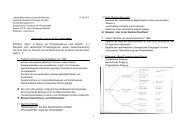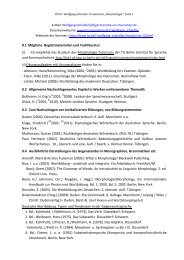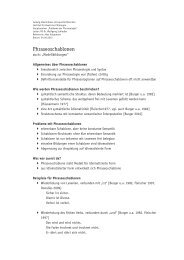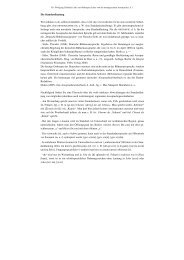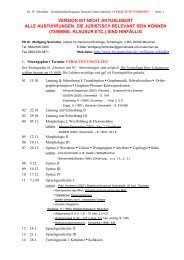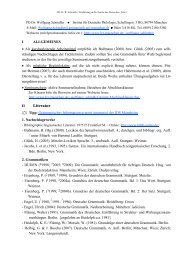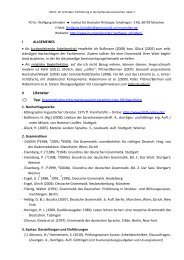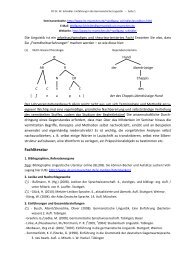Chapter 18 Lexical Functions: Description of Lexical Relations in a ...
Chapter 18 Lexical Functions: Description of Lexical Relations in a ...
Chapter 18 Lexical Functions: Description of Lexical Relations in a ...
Create successful ePaper yourself
Turn your PDF publications into a flip-book with our unique Google optimized e-Paper software.
—<strong>Chapter</strong> <strong>18</strong>. <strong>Lexical</strong> <strong>Functions</strong>— 57<br />
man-Russian). Now the reader has a detailed account <strong>of</strong> support verbs based on Spanish (Alonso<br />
Ramos 2004).<br />
Let us now return to the survey <strong>of</strong> verbal LFs.<br />
46-48. Phasal Verbs<br />
The LFs 46-48 represent the mean<strong>in</strong>g <strong>of</strong> what are <strong>of</strong>ten called phasal verbs:<br />
Incep [Lat. <strong>in</strong>cipere] carries the mean<strong>in</strong>g (beg<strong>in</strong>),<br />
Cont [Lat. cont<strong>in</strong>uāre] means (cont<strong>in</strong>ue),<br />
and F<strong>in</strong> [Lat. f<strong>in</strong>īre] means (cease).<br />
They are semantically full and l<strong>in</strong>ked by obvious semantic relations:<br />
F<strong>in</strong>(P) = Incep(NonP) [(He ceased to sleep) = (He began not to sleep)];<br />
Cont(P) = NonF<strong>in</strong>(P) = NonIncep(NonP) [(He cont<strong>in</strong>ues to sleep) = (He does not cease to sleep)].<br />
Once aga<strong>in</strong>, one can easily see the reason for a tripartite organization <strong>of</strong> these LFs (the <strong>in</strong>itial<br />
Incep plus two possible negative ‘derivations’).<br />
The three phasal LFs are applicable to verbs or verbal expressions only. Therefore, to apply<br />
one <strong>of</strong> them to a noun, even a predicate noun, a support verb is needed: (beg<strong>in</strong> negotiations) must<br />
be written as IncepOper 1 (negotiations), etc.; as a result, they are most <strong>of</strong>ten used <strong>in</strong> comb<strong>in</strong>a-<br />
tion with other LFs, i.e. <strong>in</strong> complex LFs, see below, 3.1, p. 00. A phasal verb takes L as its<br />
DSyntA II: Incep−II→L, etc.<br />
Examples<br />
IncepOper 1(fireN [shoot]) = open [~ on NY]<br />
IncepOper 2(power) = fall [under the ~→<strong>of</strong> NX]<br />
F<strong>in</strong>Oper 1(power) = lose [one’s ~→over NY]<br />
ContOper 1(power) = reta<strong>in</strong> [one’s ~→over NY]<br />
[The expression ‘~→NP’ <strong>in</strong> the reduced Government Pattern means that the NP <strong>in</strong> question<br />
syntactically depends on the key lexeme L and not on the support verb.]<br />
ContFunc 0(<strong>of</strong>fer) = stands<br />
ContFunc 0(smellN) = l<strong>in</strong>gers [Loc<strong>in</strong> N], l<strong>in</strong>gers on [here, we see an obligatory circumstan-<br />
tial (locative or temporal), which is by no means a DSyntA <strong>of</strong> SMELL]<br />
However, <strong>in</strong> pr<strong>in</strong>ciple, these LFs can be used as well outside <strong>of</strong> complex LFs, i.e., directly<br />
with verbal keywords, if the language allows for this: Rus. Incep(goret´ (burn [<strong>in</strong>trans.])) =<br />
//za+goret´+sja, Incep(plakat´ (cry)) = //za+plakat´, Incep(spat´ (sleep)) = //za+snut´,


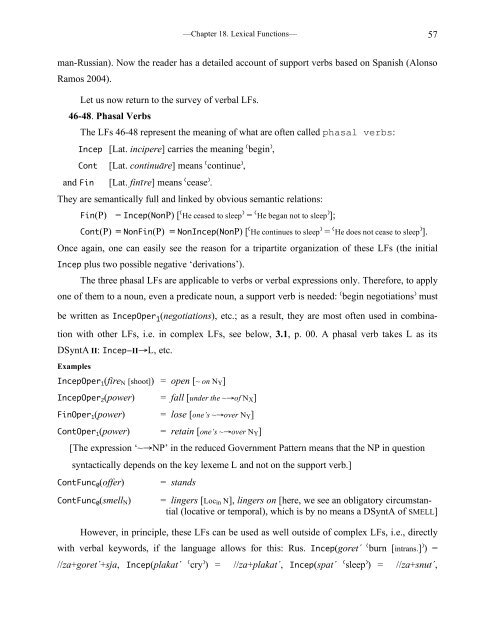
![E-Mail: Wolfgang.Schindler[ätt]germanistik.uni-muenchen.de Web ...](https://img.yumpu.com/51590147/1/184x260/e-mail-wolfgangschindlerattgermanistikuni-muenchende-web-.jpg?quality=85)
